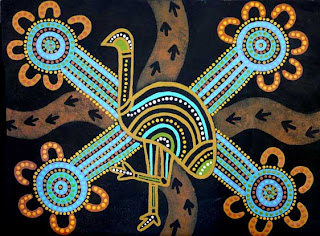The Museum of South Australia exhibited traditional Indigenous art and artefacts including decorated totems, weaving, boomerangs, bark paintings, shields, photographs and more. It was amazing to see the wealth of knowledge preserved in the displays. I had not been to the Museum since I was very young and I found it fascinating to look around and see everything with a new perspective. By viewing items up close, I am able to appreciate the fine detail and texture that can't always be seen in photos.
The paintings on the Yuendumu Doors represent significant ceremonial sites and are one of earliest examples of Aboriginal artists successfully transferring their ancient ground paintings to a large-scale contemporary medium. The description that accompanied the Doors summed up the meaning of them well saying, "The paintings meanings and stories remain complex and hidden, a cryptic reference to their dreaming - an epic drama which explains how the land, the people and their social instructions came to be as they are."
My photo of the 9 Yuendumu Doors displayed at The SA Museum.
My first impression of these works were that they looked very weathered. I could see remains of graffiti as well as scratches and chipped off paint. I liked the earthy colours used; predominatly white, red, yellow and black; as it created a sense of understanding and belonging to the land. I think this notion of the deep connection to the land that Indigenous people share is really interesting. As the doors are a larger medium, the artists seemed to use larger dots and symbols. The door in the centre was wider and used a lot of blue to contrast against the other doors and create an emphasis.

'The Doors Etchings' (shown above) were displayed next to the doors and were accompanied with an explanation saying "In 2000, twenty years after the doors were painted, the surviving artists collaborated with Northern editors to produce a series of etchings based on the original doors." I found these etchings quite intriguing as their bold colours created a strong contrast yet they all seem to connect and belong as a group.












